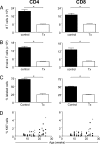Sparse production but preferential incorporation of recently produced naive T cells in the human peripheral pool
- PMID: 18420820
- PMCID: PMC2329696
- DOI: 10.1073/pnas.0709713105
Sparse production but preferential incorporation of recently produced naive T cells in the human peripheral pool
Abstract
In mice, recent thymic emigrants (RTEs) make up a large part of the naïve T cell pool and have been suggested to be a distinct short-lived pool. In humans, however, the life span and number of RTEs are unknown. Although (2)H(2)O labeling in young mice showed high thymic-dependent daily naïve T cell production, long term up- and down-labeling with (2)H(2)O in human adults revealed a low daily production of naïve T cells. Using mathematical modeling, we estimated human naïve CD4 and CD8 T cell half-lives of 4.2 and 6.5 years, respectively, whereas memory CD4 and CD8 T cells had half-lives of 0.4 and 0.7 year. The estimated half-life of recently produced naïve T cells was much longer than these average half-lives. Thus, our data are incompatible with a substantial short-lived RTE population in human adults and suggest that the few naïve T cells that are newly produced are preferentially incorporated in the peripheral pool.
Conflict of interest statement
The authors declare no conflict of interest.
Figures


References
-
- Hazenberg MD, Borghans JAM, De Boer RJ, Miedema F. Thymic output: A bad TREC record. Nat Immunol. 2003;4:97–99. - PubMed
-
- Douek D. Thymic output and HIV infection: On the right TREC. Immunity. 2004;21:744–745. - PubMed
-
- Douek DC, et al. Evidence for increased T cell turnover and decreased thymic output in HIV infection. J Immunol. 2001;167:6663–6668. - PubMed
-
- Dion ML, et al. HIV infection rapidly induces and maintains a substantial suppression of thymocyte proliferation. Immunity. 2004;21:757–768. - PubMed
-
- Hazenberg MD, et al. Increased cell division but not thymic dysfunction rapidly affects the TREC content of the naive T cell population in HIV-1 infection. Nature Med. 2000;6:1036–1042. - PubMed
Publication types
MeSH terms
Substances
LinkOut - more resources
Full Text Sources
Medical
Research Materials

